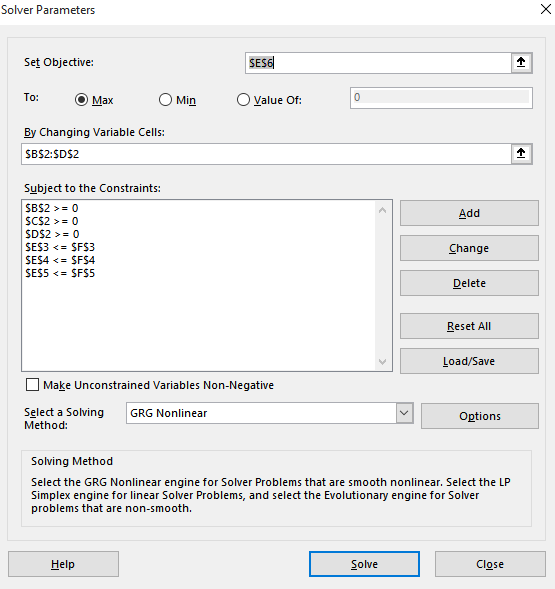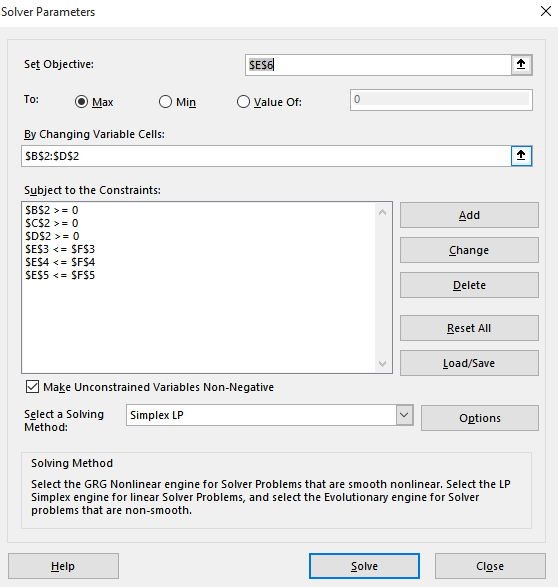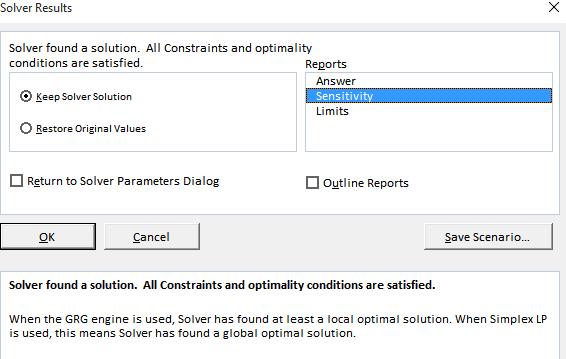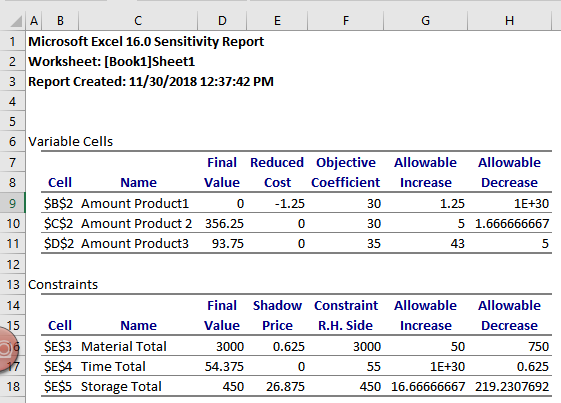
A chemical plant makes three major products on a weekly basis. Each of these products requires a certain quantity of raw chemical and different production times, and yields different profits. Thepertinentin formation is in Table P16.5. Note that there is sufficient warehouse space at the plant to store a total of 450 kg/week.
TABLE P16.5
| Product 1 | Product 2 | Product 3 | Resource Availability | |
| Raw chemical |
|
|
13kg/kg |
|
| Production time |
|
|
0.2hr/kg |
|
| Product |
|
|
|
(a) Set up a linear programming problem to maximize profit.
(b) Solve the linear programming problem with the simplex method.
(c) Solve the problem with a software package.
(d) Evaluate which of the following options will raise profits the most: increasing raw chemical, production time, or storage.
(a)
A linear programming problem for a chemical plant that makes three products on a weekly basis. The data is given below:
Answer to Problem 5P
Solution:
The Linear Programming formulation is given as:
Subject to Constraints:
Explanation of Solution
Given Information:
Following data is given for a chemical plant that makes three products on a weekly basis:
Also, the warehouse can store a total of
Let
The Linear Programming Model can be set up as follows:
As Profit is to be maximized, the objective function is
The constraints are:
The raw chemical constraint is
As the total production time must be equal to or less than
The storage available is
Also, the weights can never be negative. Thus, positivity constraint is
Hence, the Linear Programming formulation is given as:
Subject to Constraints:
(b)
To calculate: The solution of the linear programming problem given below:
Subject to Constraints:
Answer to Problem 5P
Solution:
The values of variables are
Explanation of Solution
Given Information:
A linear programming problem,
Subject to Constraints:
Calculation:
Consider the provided linear programming problem,
Subject to Constraints:
First convert the above problem to standard form by adding slack variables.
As the constraints are subjected to less than condition, non- negative slack variables are added to reach equality.
Let the slack variables be
Thus, the linear programming model would be:
The above linear programming models consist of three non-basic variables
Now the apply the Simplex method and solve the above problem as:
The negative minimum, P is
The minimum ratio is 230.7692 and it corresponds to basis variable S1. So, the leaving variable is S1.
Therefore, the pivot element is 13.
The negative minimum, P is
The minimum ratio is 356.25 and it corresponds to basis variable S3. So, the leaving variable is S3.
Therefore, the pivot element is 0.61539.
Since
Hence, the values of variables are
(c)
To calculate: The solution of the linear programming problem given below using software package:
Subject to Constraints:
Answer to Problem 5P
Solution:
The values of variables are
Explanation of Solution
Given Information:
A linear programming problem,
Subject to Constraints:
Calculation:
Consider the provided linear programming problem,
Subject to Constraints:
The solution can be obtained using Excel.
Set up the values and use the formula as shown below:

The values obtained are:

Now press Solver under Data tab and enter the constraints and objective as shown below:

The resulting solution is:

Hence, the values of variables are
(d)
The factor among increasing raw material, production time or storage that will rise profits the most for the linear programming problem given below:
Subject to Constraints:
Answer to Problem 5P
Solution:
Increasing storage will result in the most profits.
Explanation of Solution
Given Information:
A linear programming problem,
Subject to Constraints:
Calculation:
Open the Excel sheet of part (c), then Press Solver under Data and select Simplex LP as a solving method as shown below:

Press solve then select Sensitivity in reports as shown below:

The sensitivity report obtained is:

The high shadow price for storage implies that increasing storage will result in the most profits.
Want to see more full solutions like this?
Chapter 16 Solutions
EBK NUMERICAL METHODS FOR ENGINEERS
- can you please help me perform Visual Inspection and Fractography of the attatched image: Preliminary examination to identify the fracture origin, suspected fatigue striation, and corrosion evidences.arrow_forwardcan you please help[ me conduct Causal Analysis (FTA) on the scenario attatched: FTA diagram which is a fault tree analysis diagram will be used to gain an overview of the entire path of failure from root cause to the top event (i.e., the swing’s detachment) and to identify interactions between misuse, material decay and inspection errors.arrow_forwardhi can you please help me in finding the stress intensity factor using a k-calcluator for the scenario attathced in the images.arrow_forward
- Hi, can you please help me .Identify and justify suitable analytical techniques of the scenario below, bearing in mind the kinds of information being handled to reach a conclusion (methodology). A child swing set was discovered to have failed at the fixing at the top of the chains connecting the seat to the top of the swing set. A 12 mm threaded steel bolt, connecting the shackle to the top beam, failed at the start of the threaded region on the linkage closest to the outside side of the swing set . The linkage and bolts were made of electro galvanised mild steel . The rigid bar chain alternatives and fixings were of the same material and appeared to be fitted in accordance with guidelines. The yield strength of the steel used is 260 MPa and the UTS is 380 MPa. The bolt that failed was threaded using a standard thread with a pitch (distance between threads) of 1.75 mm and a depth of approximately 1.1 mm. The swing set in question had been assigned to ‘toddlers’ with the application of…arrow_forwardHi, can you please define and calculate the failure mode of the linkage that failed on the swing (images added) : A child swing set was discovered to have failed at the fixing at the top of the chains connecting the seat to the top of the swing set. A 12 mm threaded steel bolt, connecting the shackle to the top beam, failed at the start of the threaded region on the linkage closest to the outside side of the swing set . The linkage and bolts were made of electro galvanised mild steel . The rigid bar chain alternatives and fixings were of the same material and appeared to be fitted in accordance with guidelines. The yield strength of the steel used is 260 MPa and the UTS is 380 MPa. The bolt that failed was threaded using a standard thread with a pitch (distance between threads) of 1.75 mm and a depth of approximately 1.1 mm. The swing set in question had been assigned to ‘toddlers’ with the application of a caged-type seat. However, the location was within the play area not…arrow_forwardPage 11-68. The rectangular plate shown is subjected to a uniaxial stress of 2000 psi. Compute the shear stress and the tensile developed on a plane forming an angle of 30° with the longitud axis of the member. (Hint: Assume a cross-sectional area of unity) 2000 psi 2000 psi hparrow_forward
- 11-70. A shear stress (pure shear) of 5000 psi exists on an element. (a) Determine the maximum tensile and compressive stresses caused in the element due to this shear. (b) Sketch the element showing the planes on which the maximum tensile and compressive stresses act.arrow_forward11-20. An aluminum specimen of circular cross section, 0.50 in. in diameter, ruptured under a tensile load of 12,000 lb. The plane of failure was found to be at 48° with a plane perpendicular to the longitudinal axis of the specimen. (a) Compute the shear stress on the failure plane. (b) Compute the maximum tensile stress. (c) Compute the tensile stress on the failure plane. hparrow_forwardA long flat steel bar 13 mm thick and 120 mm wide has semicircular grooves as shown and carries a tensile load of 50 kN Determine the maximum stress if plate r= 8mm r=21mm r=38mmarrow_forward
- Problem 13: F₁ = A =250 N 30% Determine the moment of each of the three forces about point B. F₂ = 300 N 60° 2 m -3 m B 4 m F3=500 Narrow_forward3 kN 3 kN 1.8 kN/m 80 mm B 300 mm D an 1.5 m-1.5 m--1.5 m- PROBLEM 5.47 Using the method of Sec. 5.2, solve Prob. 5.16 PROBLEM 5.16 For the beam and loading shown, determine the maximum normal stress due to bending on a transverse section at C.arrow_forward300 mm 3 kN 3 kN 450 N-m D E 200 mm 300 mm PROBLEM 5.12 Draw the shear and bending-moment diagrams for the beam and loading shown, and determine the maximum absolute value (a) of the shear, (b) of the bending moment.arrow_forward
 Elements Of ElectromagneticsMechanical EngineeringISBN:9780190698614Author:Sadiku, Matthew N. O.Publisher:Oxford University Press
Elements Of ElectromagneticsMechanical EngineeringISBN:9780190698614Author:Sadiku, Matthew N. O.Publisher:Oxford University Press Mechanics of Materials (10th Edition)Mechanical EngineeringISBN:9780134319650Author:Russell C. HibbelerPublisher:PEARSON
Mechanics of Materials (10th Edition)Mechanical EngineeringISBN:9780134319650Author:Russell C. HibbelerPublisher:PEARSON Thermodynamics: An Engineering ApproachMechanical EngineeringISBN:9781259822674Author:Yunus A. Cengel Dr., Michael A. BolesPublisher:McGraw-Hill Education
Thermodynamics: An Engineering ApproachMechanical EngineeringISBN:9781259822674Author:Yunus A. Cengel Dr., Michael A. BolesPublisher:McGraw-Hill Education Control Systems EngineeringMechanical EngineeringISBN:9781118170519Author:Norman S. NisePublisher:WILEY
Control Systems EngineeringMechanical EngineeringISBN:9781118170519Author:Norman S. NisePublisher:WILEY Mechanics of Materials (MindTap Course List)Mechanical EngineeringISBN:9781337093347Author:Barry J. Goodno, James M. GerePublisher:Cengage Learning
Mechanics of Materials (MindTap Course List)Mechanical EngineeringISBN:9781337093347Author:Barry J. Goodno, James M. GerePublisher:Cengage Learning Engineering Mechanics: StaticsMechanical EngineeringISBN:9781118807330Author:James L. Meriam, L. G. Kraige, J. N. BoltonPublisher:WILEY
Engineering Mechanics: StaticsMechanical EngineeringISBN:9781118807330Author:James L. Meriam, L. G. Kraige, J. N. BoltonPublisher:WILEY





